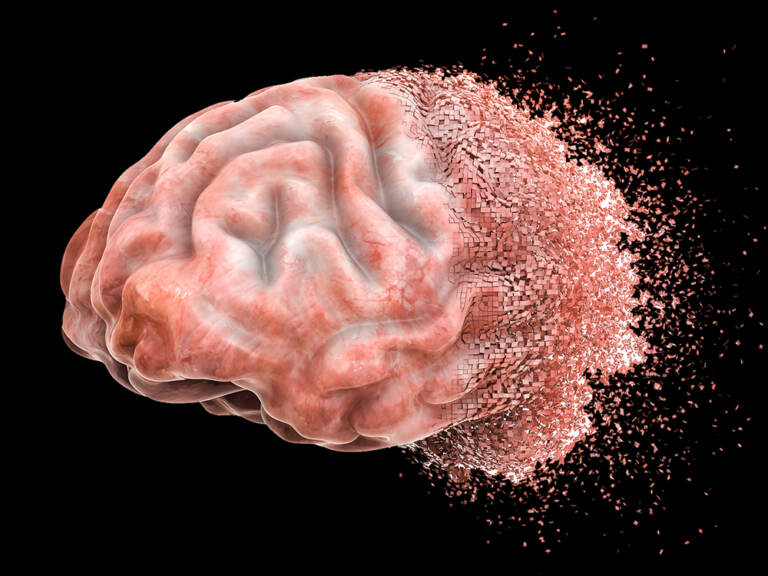If you’re a fan of Hollywood movies, you’ve probably heard of Goldfield Syndrome. It’s a fictional memory loss disorder that was created for the popular movie, “50 First Dates”. In the movie, Goldfield Syndrome is portrayed as a condition in which the sufferer loses all memory of their life every single day, waking up with a completely blank slate each morning.
However, in reality, there is no such thig as Goldfield Syndrome. Hollywood created this disorder by conflating two real memory loss syndromes, Anterograde amnesia and Transient global amnesia.
Anterograde amnesia is a real condition in which a person is unable to form new memories, but they can still remember events and experiences from before the onset of the disorder. This type of amnesia can be caused by brain trauma, stroke, or certain diseases.
Transient global amnesia (TGA) is another real memory disorder that is characterized by the sudden onset of memory loss that is usually temporary. This condition is often triggered by stress or physical exertion and typically lasts for a few hours to a day.
So, while Goldfield Syndrome may not be a real disorder, it is important to understand the real memory loss syndromes that exist. Here are some other types of amnesia that you may encounter:
1. Retrograde amnesia: This is a condition in which a person loses previously made memories. People with this type of amnesia may forget things that happened in the past, such as their wedding day or the birth of their children.
2. Infantile or childhood amnesia: This is a common type of amnesia in which a person forgets the early years of their life. Most people can’t remember anything before the age of 3 or 4.
3. Dissociative amnesia: This is a condition in which a person blocks out traumatic events from their memory. They may forget important details about a traumatic event, such as a car accident or abuse.
4. Post-traumatic amnesia: This type of amnesia is caused by a traumatic brain injury and can last for days, weeks, or even months. People with post-traumatic amnesia may have trouble forming new memories and may forget events that happened before the injury.
5. Drug-induced amnesia: Certain drugs, such as benzodiazepines or alcohol, can cause temporary amnesia. This type of amnesia usually wears off once the effects of the drug wear off.
While Goldfield Syndrome may be a fictional disorder, it is important to understand the real memory loss syndromes that exist. Memory loss can be caused by a variety of factors, and it is important to seek medical attention if you or a loved one is experiencing memory loss or other cognitive symptoms.
Does Goldfield Syndrome Exist?
Goldfield syndrome is a term that has been popularized by Hollywood, but it is not a recognized medical condition. The term seems to have been invented for the movie “50 First Dates” and is not used in the medical community. However, there are several types of memory loss syndromes that do exist and can cause short-term memory loss.
One such syndrome is anterograde amnesia, which is characterized by the inability to form new memories after a traumatic event or injury. Another type of memory loss syndrome is transient global amnesia, which is typically triggered by stress or physical exertion and cases a sudden onset of memory loss that can last for several hours.
It is important to note that memory loss can also be a symptom of other medical conditions, such as Alzheimer’s disease or dementia. Therefore, it is important to consult with a medical professional if you are experiencing any type of memory loss or cognitive impairment.
While Goldfield syndrome is not a real medical condition, there are several types of memory loss syndromes that exist and can cause short-term memory loss. It is important to seek medical attention if you are experiencing any type of memory loss or cognitive impairment.

Source: screenrant.com
Is ’50 First Dates’ Based on a Real Brain Condition?
The brain condition depicted in the movie “50 First Dates” is called Goldfield’s Syndrome, which is a fictional disorder created for the film. In reality, there is no such condition as Goldfield’s Syndrome. The movie portrays a type of anterograde amnesia, which is a real condition that affects the brain’s ability to create new memories.
Anterograde amnesia is a type of memory loss that can be caused by brain damage, alcohol abuse, or certain medications. It occurs when the brain is unable to transfer new information from short-term memory to long-term memory. People with anterograde amnesia can remember events that happened before their brain injury, but they have difficulty forming new memories.
However, the way in which Lucy’s memory degrades in the movie is ulike any actual type of anterograde amnesia. In the movie, Lucy wakes up every day thinking it is October 13th, the day before her accident. This is not how anterograde amnesia works in real life. People with anterograde amnesia can still learn new skills and form new habits, even if they don’t remember doing so. They may also be able to remember information if it is repeated to them multiple times or if it is associated with something familiar.
While the concept of anterograde amnesia is real, the specific brain condition depicted in “50 First Dates” is not. The movie takes creative liberties to tell its story, and its portrayal of memory loss is not entirely accurate.
The Effects of Daily Memory Loss
When an individual loses their memory on a daily basis, it is referred to as transient global amnesia (TGA). TGA is a rare neurological condition that typically affects people who are middle-aged or older. During an episode of TGA, a person experiences a sudden and temporary loss of memory that can last anywhere from a few hours to a full day.
The exact cause of TGA is still unknown, but it is believed to be related to a disruption in blood flow to the brain or a temporary disruption in the hippocampus, which is the part of the brain responsible for memory formation. Some potential triggers for TGA include exposure to cold water or sudden immersion in water, strenuous physical activity, emotional stress, and sexual activity.
Symptoms of TGA include sudden memory loss, confusion, repetitive questioning, and difficulty forming new memories. While the episode itsef can be distressing, TGA is generally not considered a serious or life-threatening condition, and most people make a full recovery without any long-term effects. However, it is important to seek medical attention if you or someone you know experiences an episode of TGA, as it can be difficult to distinguish from other conditions that may require more urgent treatment.
Types of Amnesia
Amnesia is a condition that affects memory and can cause difficulties in recalling information, events, or experiences. There are different types of amnesia that can affect individuals in different ways. Here are four types of amnesia:
1. Retrograde Amnesia: This type of amnesia causes a person to lose their previously stored memories. It can be caused by head injury, stroke, or other medical conditions.
2. Anterograde Amnesia: In this type of amnesia, a person is unable to form new memories ater the onset of the condition. It is often caused by damage to the hippocampus, the part of the brain responsible for memory formation.
3. Transient Global Amnesia (TGA): TGA is a temporary form of amnesia that typically lasts for several hours. During an episode, a person may experience memory loss, confusion, and disorientation. The cause of TGA is not fully understood, but it is thought to be related to changes in blood flow to the brain.
4. Infantile or Childhood Amnesia: This type of amnesia refers to the inability to recall memories from early childhood. It is thought to be caused by the immaturity of the brain’s memory system during early development.
Other types of amnesia include dissociative amnesia, which is caused by psychological trauma, and post-traumatic amnesia, which is caused by a head injury or trauma. Drug-induced amnesia can also occur as a side effect of certain medications or drugs.
Is ’10 Second Tom’ Authentic?
The character “10 Second Tom” portrayed in the film “50 First Dates” is a fictional character. However, the condition he exhibits, which is the inability to retain new memories for more than a few seconds, is a real neurological condition called anterograde amnesia. This condition is caused by damage to the hippocampus, a part of the brain that plays a crucial role in the formation of new memories.
People with anterograde amnesia experience difficulty in forming new memories, but they can sill recall events that happened before the onset of the condition. They may also be able to learn new skills or habits, but without conscious awareness of having learned them.
While the character “10 Second Tom” is fictional, the condition that he exhibits, anterograde amnesia, is a real neurological condition that affects people’s ability to form new memories.

The Reality of Short-term Memory Loss
Short-term memory loss is a real condition that affects many people, particularly as they age. Short-term memory refers to the ability to remember information that was recently learned or experienced, usually within the last few minutes or hours. This type of memory is important for daily activities such as remembering what you just read, following instructions, and maintaining conversations.
Short-term memory loss can occur for various reasons. In some cases, it is a normal part of aging, as the brain’s ability to retain information gradually declines over time. Other factors that can contribute to short-term memory loss include stress, lack of sleep, certain medications, and health conditions such as depression and anxiety.
However, short-term memory loss can also be a sign of a more serious problem such as dementia, Alzheimer’s disease, or a brain injury. In these cases, the memory loss is often accompanied by other symptoms such as confusion, difficulty with language, and changes in mood or behavior.
If you or someone you know is experiencing persistent short-term memory loss, it is important to seek medical attention to determine the underlying case and explore treatment options. This may involve cognitive therapy, medication, or other interventions depending on the specific diagnosis.
The Reality of Memory Loss: A Comparison to the Movie ’50 First Dates’
Memory loss can occur due to various factors such as brain injury, stroke, dementia, and neurological disorders. While some forms of memory loss may resemble the fictional condition depicted in the movie 50 First Dates, it is important to note that the condition portrayed in the film is not a real medical condition.
In 50 First Dates, the character Lucy suffers from a form of memory loss that prevents her from forming new memories. This condition is similar to anterograde amnesia, a type of amnesia that affects the ability to create new memories after the onset of amnesia. However, this condition is rare, and most cases of amnesia do not involve a complete inability to form new memories.
Other forms of memory loss include retrograde amnesia, which affects the ability to recall past events, and transient global amnesia, a temporary episode of memory loss that typically resolves on its own. Memory loss can also be a symptom of other conditions, such as Alzheimer’s disease, Parkinson’s disease, and traumatic brain injury.
It is important to note that memory loss can have a significant impact on a person’s quality of life, affecting their ability to perform daily activities and maintain social relationships. If you or someoe you know is experiencing memory loss, it is important to seek medical attention to determine the underlying cause and explore potential treatment options.
Here are some potential causes of memory loss:
– Brain injury
– Stroke
– Dementia
– Neurological disorders
– Alcoholism and drug abuse
– Depression and anxiety
– Sleep disorders
– Vitamin B12 deficiency
If you or someone you know is experiencing memory loss, it is important to speak with a healthcare professional to determine the underlying cause and identify potential treatment options.
Drew Barrymore’s Struggle with Disease
Drew Barrymore, the renowned American actress and producer, recently shared that she had tested positive for Covid-19. The 46-year-old actress took to her Instagram account on Tuesday to update her fans about her health status. According to her, she had contracted the disease and had been in quarantine for the past few days.
Covid-19, also known as the coronavirus disease, is a highly infectious respiratory illness caused by the SARS-CoV-2 virus. The disease first emerged in Wuhan, China, in December 2019, and has since spread globally, causing a pandemic. The virus spreads through respiratory droplets when an infected person talks, coughs, or sneezes. It can also spread by touching a contaminated surface and then touching one’s face.
The symptoms of Covid-19 vary from person to person but can include fever, cough, fatigue, body aches, loss of taste or smell, difficulty breathing, and sore throat. In severe cases, the disease can lead to pneumonia, acute respiratory distress syndrome, and death.
It is essential to follow public health guidelines to prevent the spread of Covid-19, such as wearing masks, practicing social distancing, washing hands regularly, and avoiding large gatherings. Vaccines are also availale to protect against the disease, and people are encouraged to get vaccinated as soon as possible.
Drew Barrymore was diagnosed with Covid-19, a highly infectious respiratory illness caused by the SARS-CoV-2 virus. The disease can cause a range of symptoms, and it is crucial to follow public health guidelines to prevent its spread. Vaccines are also available to protect against the disease.
The Condition Suffered by 10 Second Tom in 50 First Dates
In the movie 50 First Dates, the character Tom is portrayed as a person who has suffered a severe brain injury during a hunting accident. This injury has resulted in a unique and rare condition called anterograde amnesia, which is characterized by the inability to form new memories after the event that caused the injury.
Tom’s memory only lasts for a duration of ten seconds, which means that he is unable to recall events that have occurred just a few moments ago. This condition makes it difficult for him to carry out daily activities such as holding a job, forming relationships, and remembering important events.
Anterograde amnesia is a type of amnesia that affects the ability to create new memories, while leaving old memories intact. It is caused by damage to the hippocampus, a part of the brain responsible for memory consolidation. In Tom’s case, the damage was extensive and has led to a permanent loss of memory function.
To cope with his condition, Tom uses a system of notes and reminders to help him remember important information. He also relies on the people around him to fill in the gaps in his memory and provide him with the neessary information to carry out his daily activities.
Overall, Tom’s condition in 50 First Dates is a rare and debilitating form of amnesia that affects his ability to form new memories and remember important information.

The Phenomenon of Waking Up and Not Remembering Anything
The condition where you wake up and cannot remember anything is called sleep amnesia. Sleep amnesia is a type of memory loss that occurs during or after waking up from sleep. It can be caused by a number of factors, including sleep deprivation, stress, and certain medications. Sleep amnesia can affect differnt people in different ways. Some people may experience complete memory loss, while others may only have partial memory loss. In some cases, sleep amnesia may be a symptom of a more serious underlying health condition, such as Alzheimer’s disease or dementia. If you are experiencing sleep amnesia on a regular basis, it is important to speak with your doctor to determine the underlying cause and to receive proper treatment.
The Effects of Age on Memory Decline
Memory decline is a natural part of the aging process, and it is normal for people to experience some form of memory loss as they get older. Research has shown that memory decline typically begins in our late 20s or early 30s, but it is not until we reach our mid-60s that we start to notice a more significant decline.
According to studies, almost 40% of people experience some form of memory loss after they turn 65 years old. However, it is important to note that not all memory loss is a sign of dementia or other cognitive disorders. In most cases, the memory loss is mild enough that it does not interfere with day-to-day activities.
It is also important to note that tere are factors that can impact memory decline, such as genetics, lifestyle, and medical conditions. For example, a healthy diet, regular exercise, and mental stimulation can help slow down memory decline.
Memory decline is a normal part of the aging process, and it typically starts in our late 20s or early 30s. However, it is not until we reach our mid-60s that we start to notice a more significant decline.
The Causes of Forgetting Things Immediately After Thinking of Them
Forgetting things immediately after thinking of them can be frustrating and worrisome. There are several reasons why this can happen, including stress, depression, lack of sleep, and thyroid problems. Stress and depression can affect your ability to focus and concentrate, leading to forgetfulness. Lack of sleep can also impair your memory and cognitive function.
In addition to these underlying causes, certain medications can also cause forgetfulness as a side effect. An unhealthy diet and dehydration can also contribute to memory problems.
If you are experiencing forgetfulness, it is important to address any underlying issues, such as stress or lack of sleep. Additionally, making lifestyle changes such as eating a healthy diet and staying hydrated can also help improve your memory.
To improve your memory, you can also try techniques such as repetition, visualization, and association. For example, repeating information out loud or writing it down can help reinforce it in your memory. Visualizing the information or associating it with something else can also help make it easier to remember.
Forgetfulness immediately after thinking of something can have several underlying causes, including stress, depression, lack of sleep, and medication side effects. Making lifestyle changes and usng memory-enhancing techniques can help improve your memory.
The Rarest Form of Amnesia
Functional amnesia is considered to be the rarest form of amnesia. Unlike neurological amnesia, which is associated with brain trauma or disease, functional amnesia occurs due to emotional trauma. This type of amnesia is characterized by retrograde amnesia, which is the inability to recall past inormation or events.
Functional amnesia is a type of dissociative disorder that affects an individual’s ability to remember personal details, such as their name, family members, or past experiences. The memory loss is often sudden, and the individual may have no recollection of events leading up to the onset of amnesia.
Functional amnesia can be temporary or long-lasting, and it can affect people of any age and gender. It is important to note that functional amnesia is not caused by physical damage to the brain, but rather psychological factors such as extreme stress, anxiety, or depression.
Symptoms of functional amnesia may include confusion, disorientation, and the feeling of being lost. Treatment for functional amnesia typically involves psychotherapy, which helps the individual explore and resolve any underlying emotional trauma that may be causing the memory loss.
Functional amnesia is the rarest form of amnesia and is caused by emotional trauma rather than physical damage to the brain. It is characterized by retrograde amnesia and can be treated with psychotherapy.

The Most Common Memory Disorder
Alzheimer’s disease is the most common memory disorder, affecting millions of people worldwide. It is a form of dementia that results from changes to nerves in the brain, whih become tangled, form plaques, and lose their connections to other nerves. These changes lead to the gradual deterioration of memory, thinking, and behavior, and the disease typically worsens over time.
The symptoms of Alzheimer’s disease vary from person to person, but some common signs include:
– Memory loss: difficulty remembering recent and past events, repeating questions, and relying on memory aids.
– Difficulty with language: struggling to find the right words, following conversations, and understanding written or spoken language.
– Poor judgment and decision-making: making poor choices, neglecting personal hygiene, and experiencing changes in mood or behavior.
– Problems with visual-spatial abilities: difficulty with balance, coordination, and visual perception.
– Changes in personality and mood: becoming withdrawn, depressed, anxious, agitated, or suspicious.
Unfortunately, there is no cure for Alzheimer’s disease, but there are treatments available to help manage the symptoms and slow down the progression of the disease. These may include medications, lifestyle changes, and support from caregivers and healthcare professionals.
If you or someone you know is experiencing memory loss or other symptoms of Alzheimer’s disease, it is important to seek medical advice as soon as possible. Early diagnosis and treatment can help to improve quality of life and delay the onset of more severe symptoms.
Types of Forgetting
Forgetting is a common phenomenon that occurs in our everyday lives. There are several types of forgetting, each with different causes and characteristics. Here are seven common types of forgetting:
1. Transience: This type of forgetting occurs when memories fade over time. It can happen to both short-term and long-term memories.
2. Absentmindedness: This type of forgetting occurs when we fail to pay attention to something we need to remember. It can result in forgetting things like where we put our keys or what we were supposed to pick up from the store.
3. Blocking: This type of forgetting occurs when we know we have a memory but can’t seem to retrieve it. It’s like having a word on the tip of your tongue but not being able to say it.
4. Misattribution: This type of forgetting occurs when we remember something incorrectly or confuse it with another memory. For example, we might think we heard a rumor from a friend when it was actually from a news article.
5. Suggestibility: This type of forgetting occurs when our memories are influenced by outside factors, such as leading questions or subtle cues. This can result in false memories or distorted recollections.
6. Bias: This type of forgetting occurs when our memories are influenced by our beliefs, attitudes, or expectations. We might remember something differently based on our preconceptions or biases.
7. Persistence: This type of forgetting occurs when we can’t seem to forget something we want to forget, such as a traumatic event or embarrassing moment. It can be difficult to move past thse memories and can have a negative impact on our mental health.
Forgetting is a complex process with many different types and causes. Understanding these types of forgetting can help us better manage our memories and avoid memory errors.
Conclusion
Goldfield’s Syndrome is a fictional disorder created for the movie “50 First Dates”. While it may not exist in real life, it is true that anterograde amnesia can cause significant memory loss and affect a person’s ability to form new memories. It is important to note that amnesia is not aways portrayed accurately in movies and television shows. There are different types of amnesia, including retrograde amnesia, anterograde amnesia, transient global amnesia, infantile or childhood amnesia, dissociative amnesia, post-traumatic amnesia, and drug-induced amnesia. It is essential to understand that amnesia can be caused by various factors, including physical trauma, illness, and emotional stress. while Goldfield’s Syndrome may not be a real condition, raising awareness about the different types of amnesia is crucial in promoting understanding and empathy towards individuals who may be struggling with memory loss.
